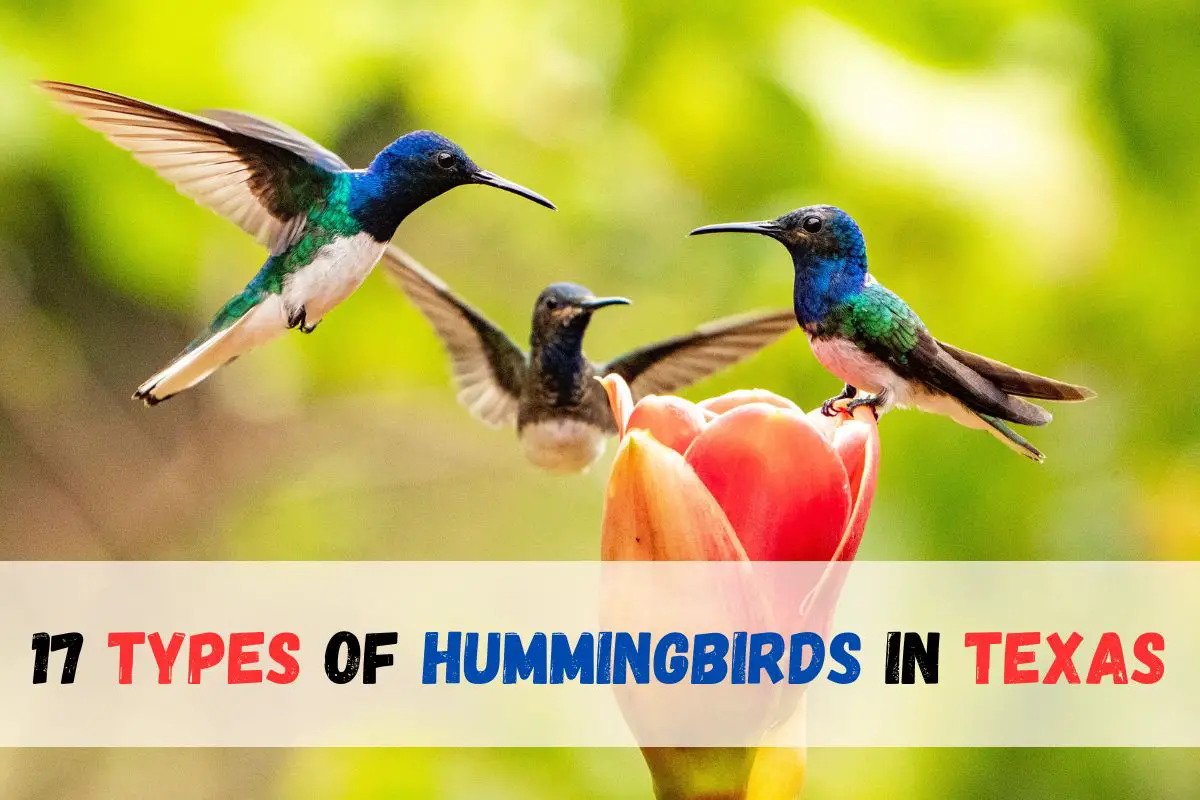Texas is a haven for hummingbirds, boasting a diverse range of species that captivate birdwatchers and nature enthusiasts alike. With its varied landscapes, from arid deserts to lush forests, Texas provides an ideal environment for these enchanting creatures.
The Texas spring and summer months witness an influx of hummingbirds as they seek out the profusion of wildflowers and garden blooms. Hummingbirds are particularly attracted to tubular flowers, such as those of the trumpet vine, salvia, and various types of sage. These plants provide the high-energy nectar that sustains these birds, fueling their rapid wing beats and energetic lifestyle.
19 Types of hawks in Texas
Gardeners and bird enthusiasts in Texas often set up hummingbird feeders to attract these delightful visitors. These feeders, filled with a mixture of sugar water, mimic the nectar found in flowers and provide a readily available food source. Many residents take joy in observing hummingbirds feeding in their yards, creating a sense of connection with the natural beauty of Texas.
17 Types of Hummingbirds in texas
Ruby-throated Hummingbird
Introduction:
Ruby-throated Hummingbirds, scientifically known as Archilochus colubris, are captivating creatures known for their vibrant appearance and remarkable behaviors. In Texas, particularly in cities like Austin, Houston, and Dallas, these hummingbirds are a common sight, adding a touch of natural splendor to the region.
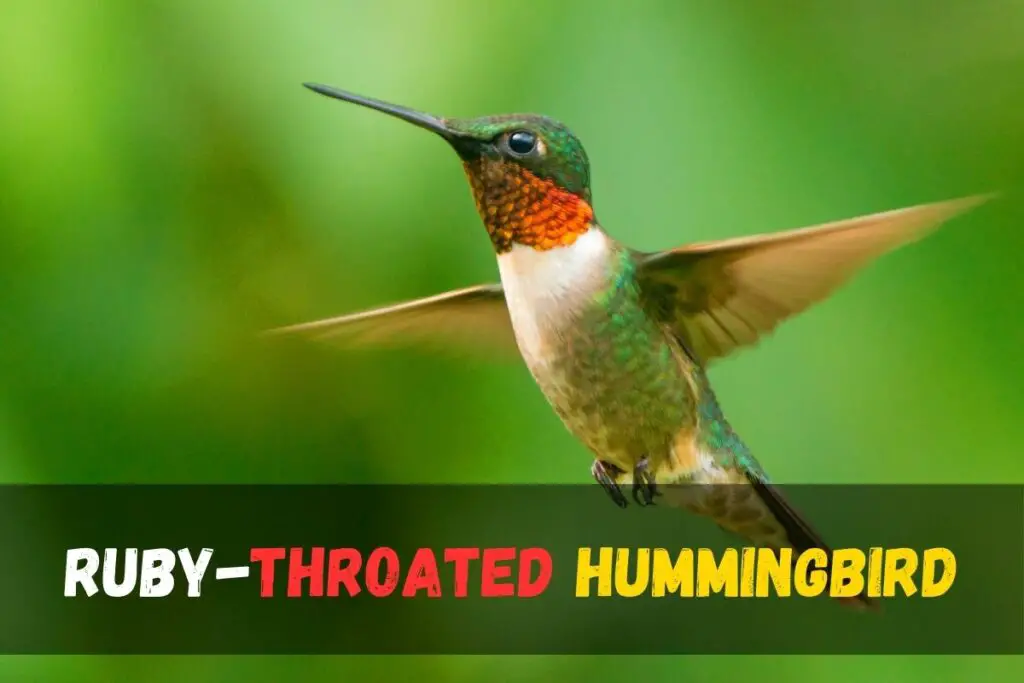
Identification:
The male Ruby-throated Hummingbird is a medium-sized species, measuring between 2.8 to 3.5 inches and weighing approximately 0.1 to 0.2 ounces. Its wingspan ranges from 3.1 to 4.3 inches. Easily distinguishable, males flaunt a bright red throat, contrasting with a black chin and mask extending behind the eyes. The top of their head and back shimmers with iridescent green. In contrast, females are duller, with a white throat and pale green streaks, lacking the distinctive black chin and red throat.
Where to Look for Them:
These hummingbirds are commonly found in various habitats in Texas, including woodlands, gardens, and parks. During the breeding season, they nest in deciduous or coniferous trees, often choosing well-hidden locations such as branches or shrubs.
Appearance:
In addition to their distinctive coloring, Ruby-throated Hummingbirds showcase remarkable aerial prowess. Their slender bodies, averaging 3-3.75 inches in size, are complemented by a white throat and blunt, rounded tail feathers in females. Males boast an emerald green upper body, contributing to their overall striking appearance.
Habitat:
Ruby-throated Hummingbirds display adaptability in their choice of habitat, being observed in various environments. In Texas, their presence is prominent during the breeding season, contributing to the biodiversity of East Texas. Nesting primarily in trees, these hummingbirds demonstrate a preference for deciduous and coniferous varieties.
Diet:
Their diet primarily consists of nectar from flowering plants, facilitated by their long, slender beaks and tongues. These agile birds also consume small insects and spiders, ensuring a balanced intake of necessary proteins and nutrients. The high metabolism and energy demands of Ruby-throated Hummingbirds necessitate frequent visits to numerous flowers, consuming substantial quantities of nectar each day.
Population:
Ruby-throated Hummingbirds play a vital role in the ecosystem, contributing to pollination and maintaining ecological balance. Conservation efforts focus on protecting and restoring their natural habitats, which include woodlands, gardens, and meadows. Unfortunately, their populations face threats from pesticide use and habitat destruction, making awareness and conservation initiatives crucial to their survival.
Broad-tailed Hummingbird
Identification
Broad-tailed Hummingbirds (Selasphorus platycercus) are a distinctive species known for their unique characteristics and behaviors. These hummingbirds can be easily identified based on their size, plumage, and vocalizations.
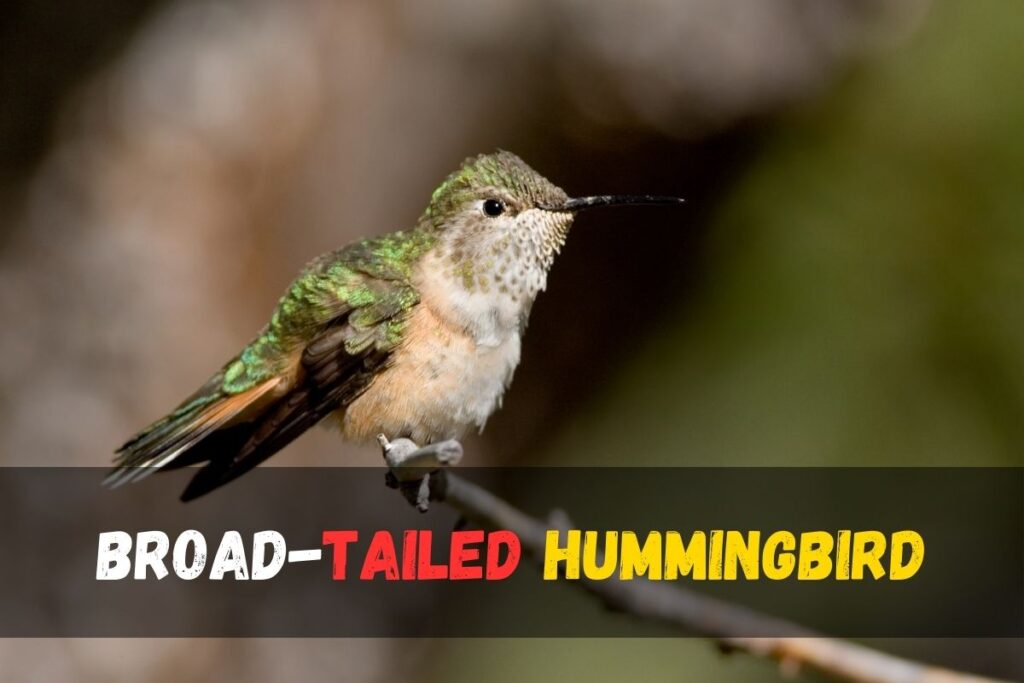
Physical Characteristics
With an average length ranging from 3.1 to 4.3 inches and weighing between 3 to 5 grams, Broad-tailed Hummingbirds are of moderate size within the hummingbird family. Males are particularly striking with a metallic green back, a bright red throat patch, and a turquoise-green head and body. In contrast, females lack the flashy throat patch and have buff-colored underparts.
Vocalizations
During courtship displays, the male Broad-tailed Hummingbird produces a distinct high-pitched “peep,” contributing to the melodious symphony in their mountainous habitats. Additionally, they are known for a distinctive “chip” call during courtship displays and territorial encounters, setting them apart from other hummingbird species.
Where to Look for Them
In Texas, Broad-tailed Hummingbirds are commonly found in western regions, including areas like El Paso, Big Bend National Park, Midland, and Amarillo. These hummingbirds prefer mountainous landscapes, meadows, and open woodlands, especially during the breeding season.
Appearance and Habitat
Recognized by their shimmering plumage, males display a red throat, white chest, and a turquoise-green head and body. Females, on the other hand, have a white throat and body with dark tail feathers and white tips. Broad-tailed Hummingbirds often build their nests on evergreen or aspen branches, incorporating plant fibers, moss, spider silk, lichens, and bits of bark for camouflage.
Diet and Foraging Behavior
These hummingbirds primarily feed on nectar from various flowers, including penstemons, columbines, larkspur, sage, and scarlet gilia. Notably, they supplement their diet with small insects and spiders, showcasing exceptional foraging abilities and precise hovering flight.
Population and Conservation
The Broad-tailed Hummingbird population is currently categorized as “Least Concern.” However, conservation efforts focus on preserving their high-altitude forest habitats, which face threats from deforestation, climate change, and human development. Protecting these areas ensures the availability of suitable nesting sites and ample food sources.
Buff-bellied Hummingbird
The Buff-bellied Hummingbird (Amazilia yucatanensis) is a captivating species primarily found in southern and southeastern Texas, including cities like Corpus Christi and Houston. These tropical beauties are also spotted in Louisiana, making Texas and Louisiana the exclusive U.S. states to host them. With their enchanting emerald-green feathers and distinctive buff-colored bellies, Buff-bellied Hummingbirds are a delightful sight.

Appearance:
Measuring around 4 ¼ inches on average, these hummingbirds boast a brilliant red bill and males exhibit a stunning blue-green throat and breast, complemented by a brown tail. Females share a similar appearance. Their curved bills are perfectly adapted for sipping nectar, showcasing their essential role in pollination as they flit from flower to flower.
Habitat and Where to Look for Them:
Buff-bellied Hummingbirds prefer semi-open habitats, woodland edges, and suburban gardens. They can be commonly sighted in the Rio Grande Valley of Texas, particularly enjoying nectar from flowers along riverbanks and shrubs. These birds are also drawn to hummingbird feeders, making them accessible for observation.
Diet:
The diet of Buff-bellied Hummingbirds primarily consists of nectar from flowers. They are known to visit backyards for flowers or nectar feeders. Additionally, small insects form a part of their diet, showcasing their adaptability and diverse foraging habits.
Population and Migration:
The population status of Buff-bellied Hummingbirds is classified as “Least Concern.” While they breed in southern Texas and the Yucatan peninsula of Mexico, they undertake short-distance migrations along the Gulf Coast, reaching Louisiana and Florida during the winter. Interestingly, Buff-bellied Hummingbirds are among the few hummingbirds that do not migrate south following the breeding season.
Nesting and Vocalizations:
Nesting occurs in Texas from April to August, with nests typically located in large shrubs or small trees, close to the ground. They produce a pair of white eggs and can have up to two broods annually. One fascinating aspect of these hummingbirds is their distinctive vocalizations, producing a variety of chirps and trills to communicate with their fellow feathered friends.
Blue-throated Mountain Gem
Identification
The Blue-Throated Mountain Gem (scientific name: Lampornis clemenciae) is a remarkable hummingbird species found in the southwestern United States, specifically in Texas, Arizona, and New Mexico. Identified by its distinctive iridescent blue throat, the males of this species are the largest hummingbirds nesting in the U.S.
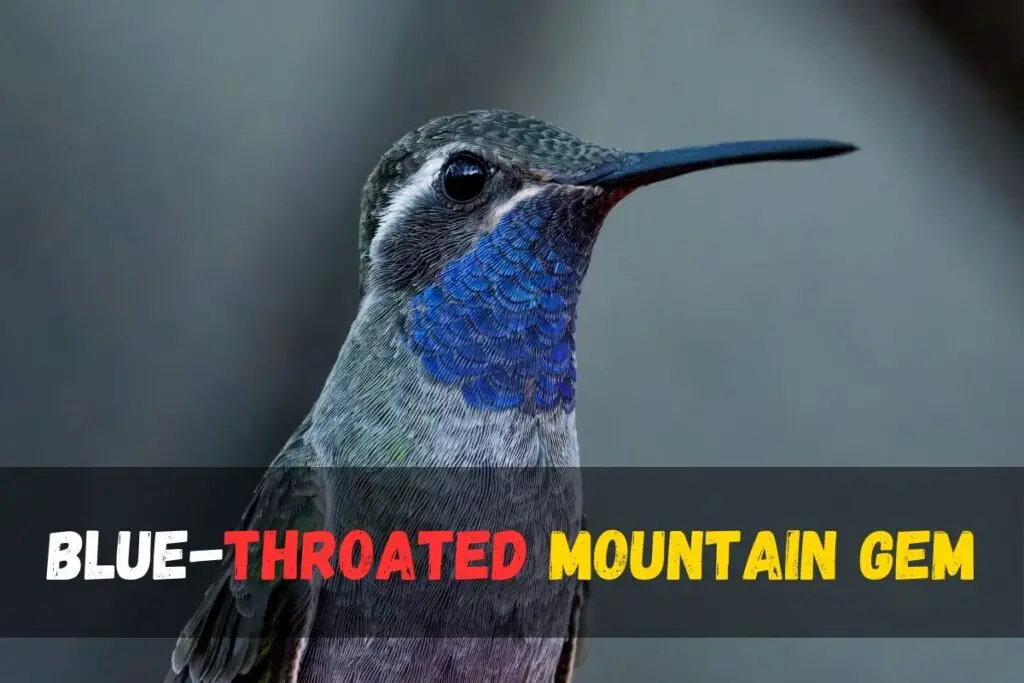
Where to Look for Them
If you’re an avid bird-watcher or nature enthusiast seeking the Blue-Throated Mountain Gem, your best bet is exploring habitats around Big Bend National Park in Texas. While Arizona boasts the largest distribution, these hummingbirds can occasionally be spotted in specific areas of Texas and New Mexico.
Appearance
The Blue-Throated Mountain Gem is a visual marvel, adorned with shimmering emerald and sapphire blue feathers. Both male and female exhibit bronzy-green coloring on their backs and grayish tones below, with distinctive white tips on their black tail feathers. The bird possesses a long, slender bill adapted for reaching deep into flowers, showcasing precision and grace in extracting nectar.
Habitat
These hummingbirds primarily inhabit mountain woodlands along streams, particularly in regions with abundant flowers or near backyards equipped with feeders. Their nests, constructed by females, are small cup-shaped structures made from plant fibers, moss, and spider silk, strategically camouflaged with lichens and bits of bark on tree branches.
Diet
The Blue-Throated Mountain Gem sustains itself on a diverse diet, primarily consisting of nectar from various flowering plants such as agave and vines. Their long beaks enable them to access deep within flowers to extract nectar. Additionally, they feed on small insects and spiders, ensuring a balance of essential protein and nutrients in their diet.
Population
This species is of conservation concern due to habitat loss and fragmentation caused by deforestation and urbanization. The high-elevation cloud forest habitats crucial for their survival require protection. Conservation efforts focus on preserving intact forest areas, establishing protected zones, and promoting sustainable land-use practices.
In Texas, the Blue-Throated Mountain Gem is a captivating yet elusive species. Its limited range in the state, particularly around Big Bend National Park, observes these hummingbirds a rewarding and unique experience for bird enthusiasts.
Black-chinned Hummingbird
Identification
The Black-chinned Hummingbird (Archilochus alexandri) is a distinctive species known for its bright purple band at the base of a black head and throat. The males have a unique black chin, while females exhibit a white chest and a green head and body. This hummingbird species is relatively small, with an average length of 3 ¾ inches.

Where to Look for Them
Black-chinned Hummingbirds can be found in various habitats, ranging from deserts to mountains and even urban areas. In Texas, they are common in central and western regions. The best way to attract these hummingbirds in Texas is by placing nectar feeders and cultivating colorful, nectar-rich native flowers.
Appearance
Males sport a distinctive black chin, while females have a white throat with black dots. The metallic green body and slender straight bill are characteristic features of the Black-chinned Hummingbird.
Habitat
Their habitat preference includes deserts, mountains, and urban areas. In Texas, they are commonly seen in the western parts, and they migrate north from Mexico and Central America each year.
Diet
These hummingbirds have a diverse diet primarily consisting of nectar from various flowering plants such as penstemon and cacti. Their long, slender beaks enable them to access nectar deep within flowers. Additionally, they consume small insects and spiders, providing essential protein and nutrients.
Population
Habitat loss and degradation resulting from urban development and agriculture pose significant conservation challenges for the Black-chinned Hummingbird. Conservation efforts focus on protecting their breeding habitats, including shrublands and riparian areas. Despite these challenges, they are classified as “Least Concern” in terms of their conservation status.
In cold weather, these hummingbirds exhibit remarkable behavior by consuming up to three times their body weight in nectar. Their migration spans over 2,000 miles, showcasing their extraordinary journey from breeding grounds to wintering grounds in Mexico.
Calliope Hummingbird
Identification
Calliope Hummingbirds, scientifically known as Selasphorus calliope, are a captivating species known for their petite size and vibrant plumage. Identifying these hummingbirds in Texas requires an understanding of their distinct characteristics.

Appearance:
Measuring around 3 inches in length, the Calliope Hummingbird holds the title of the smallest bird species in Texas. Male Calliopes boast a dark green back and a long, magenta throat adorned with white streaks, known as the gorget. Females, on the other hand, display a mostly gray and white plumage. These tiny aviators are truly a marvel to behold, showcasing their unique and striking features.
Where to Look for Them:
Western parts of Texas, including notable locations like Big Bend National Park and El Paso, serve as transient homes for Calliope Hummingbirds during migration. Observers can catch glimpses of these hummingbirds as they pass through Texas in late September or early October. Their migratory journey covers as much as 5,000 miles, predominantly to the Pacific Northwest and western Canada for breeding.
Habitat:
Calliope Hummingbirds exhibit a preference for montane habitats, often found in coniferous forests and meadows. Their breeding grounds extend to the northwestern United States and Canada, where they construct cup-shaped nests using plant fibers, lichens, and spider silk. These nests are strategically placed on tree branches or shrubs, providing a secure haven for their eggs and young.
Diet:
Feeding primarily on flower nectar, Calliope Hummingbirds utilize their long, slender bills to access nectar deep within tubular flowers. This efficient feeding method allows them to sustain their energy during their remarkable long-distance migrations. Additionally, their diet includes small insects and spiders, contributing essential proteins and nutrients to their nutrition.
Population:
While the Calliope Hummingbird is considered the smallest bird species in Texas, its population faces conservation challenges due to habitat loss and degradation. Deforestation and land development threaten their preferred habitats in mountainous areas and forests. Conservation efforts focus on creating protected areas, promoting reforestation initiatives, and raising awareness to safeguard these remarkable creatures.
Rufous Hummingbird
Identification:
Rufous Hummingbirds, scientifically known as Selasphorus rufus, are vibrant avian species known for their fiery orange and red coloration. Males exhibit bright orange-red throat and upperparts, while females have a mix of green and reddish-brown feathers. They are relatively small, with a size ranging from 2.75 to 3.75 inches and an average weight of a little more than 3 grams.
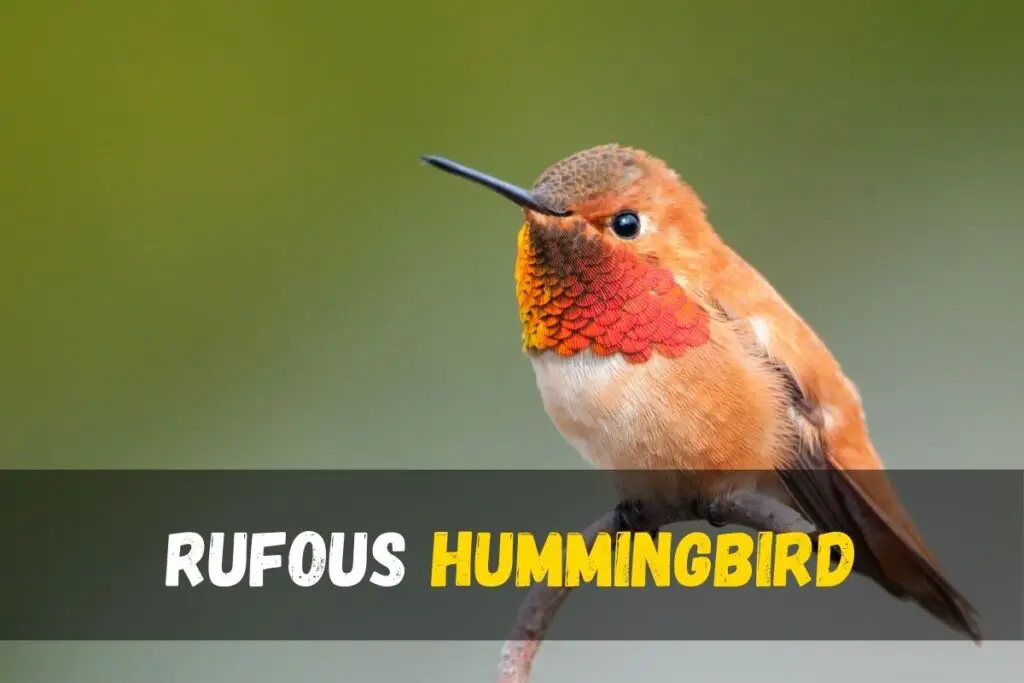
Where to Look for Them:
In Texas, Rufous Hummingbirds are primarily found in the western half of the state. If you reside west of Dallas/Ft. Worth, you might be fortunate enough to spot them, especially during their migrations.
Appearance:
The distinctive appearance of Rufous Hummingbirds includes the bright copper-orange coloration in males and a more subdued mix of colors in females. Their territorial and aggressive nature makes them easily recognizable, especially during interactions with other hummingbirds.
Habitat:
Rufous Hummingbirds are adaptable and can be found in various habitats, including mountain forests, chaparral, and gardens. They are known to breed in the western and northern parts of Texas.
Diet:
These hummingbirds have a diverse diet, consisting of nectar from flowering plants like penstemons and salvias. They also eat tiny insects and spiders to enhance their nutritional intake. Their long, curved beaks enable them to access deep within flowers for nectar.
Population:
The population of Rufous Hummingbirds faces conservation challenges due to habitat loss, climate change, and competition with other hummingbird species. Conservation efforts focus on protecting and restoring their habitats, especially in key migration corridors. Monitoring populations and studying migratory patterns contribute to a better understanding of their conservation needs.
Lucifer Hummingbird
Introduction:
The Lucifer Hummingbird, scientifically known as Calothorax lucifer, is a captivating species renowned for its celestial presence. In this discussion, we delve into various aspects of these hummingbirds, focusing on their identification, appearance, habitat, diet, and population in Texas.

Identification:
Lucifer Hummingbirds are easily recognizable by their distinctive features. With a length of around 3.5 inches, a weight of 0.1 ounces, and a wingspan of 4 inches, they boast iridescent green feathers, an elongated bill, and a striking curved crest. Males exhibit a brilliant purple throat with green markings, while females, slightly larger, lack the purple throat and are typically peach and white.
Where to Look for Them:
While these hummingbirds are rare in Texas, they have been spotted breeding in the Chisos mountains. Their usual residency lies in central Mexico. Unlike most hummingbirds that perform courtship displays near feeding areas, Lucifer Hummingbirds often engage in courtship right at the female’s nesting spot.
Appearance:
Males, with their purple throat, long forked tail, and unique downward arching bill, showcase a length of around 3.5 inches. Females, slightly larger, lack the purple throat and present a peach and white coloration with a rounded tail.
Habitat:
Lucifer Hummingbirds face conservation challenges primarily due to habitat loss and degradation. Protecting their breeding and wintering habitats is crucial for their survival. Key habitats, including protected areas and private lands with suitable vegetation, are being identified and conserved.
Diet:
The diet of Lucifer Hummingbirds primarily consists of nectar from various flowering plants such as agave and ocotillo. Their specialized tongues and long, curved bills enable them to access nectar deep within flowers. Additionally, they supplement their diet with small insects and spiders, ensuring a balance of essential protein and nutrients.
Population:
In Texas, Lucifer Hummingbirds have a breeding population in the Big Bend National Park area, extending into extreme southern New Mexico and Arizona near the border. They can be observed in these areas from early March to early November each year.
Anna’s Hummingbird
Identification
In the vast and diverse landscapes of Texas, one can encounter the captivating Anna’s Hummingbirds, scientifically known as Calypte anna. These remarkable creatures are a year-round presence along the Pacific Coast, distinguishing themselves with their unique features and behaviors.

Appearance:
Anna’s Hummingbirds are primarily identified by their distinctive emerald-green plumage, with males boasting an eye-catching magenta gorget and crown. The females, on the other hand, exhibit pink flecks on the throat and are predominantly emerald with a white-gray chest. Male Anna’s Hummingbirds are the sole species in North America to showcase a red crown, a standout feature making them easily recognizable.
Habitat and Where to Look for Them:
These hummingbirds have a preference for various habitats, including coastal scrublands, urban gardens, backyards, parks adorned with colorful blooms, and even scrub and savannah areas. High in trees, around 6 to 20 feet, Anna’s Hummingbirds build their nests. They tend to be particularly prevalent in western Texas and Arizona, with occasional sightings in western and northwestern Texas.
To catch a glimpse of these fascinating creatures, one should explore locations with large, colorful flowers and nectar feeders. Additionally, keeping an eye on hummingbird-friendly gardens, especially those focusing on native plants, is likely to yield rewarding sightings.
Diet:
Anna’s Hummingbirds maintain a diverse diet, encompassing nectar, insects, and tree sap. Their long, slender bills and specialized tongues enable them to access deep flowers, showcasing remarkable agility. Notably, they engage in mid-air acrobatics to catch insects and are known to puncture tree bark to extract sugary tree sap.
Population:
While Anna’s Hummingbirds are relatively abundant in Texas, their populations face threats due to habitat loss and fragmentation. Conservation efforts are underway, emphasizing the preservation of native plant species and the creation of suitable habitat corridors. Collaborative initiatives between organizations and communities aim to establish hummingbird-friendly environments, ensuring the flourishing of Anna’s Hummingbirds for generations to come.
In terms of numbers, out of 10,000 hummingbird sightings in Texas, approximately 91 are likely to be Anna’s Hummingbirds. Their stable populations underscore the importance of continued conservation efforts.
Broad-billed Hummingbird
Identification
Broad-billed Hummingbirds (Scientific name: Cynanthus latirostris) are enchanting avian species known for their vibrant colors and remarkable behaviors. Identifying these hummingbirds involves recognizing distinctive features that set them apart from other species.

Appearance:
The male Broad-billed Hummingbird is a visual masterpiece, showcasing a blend of blue, green, teal, purple, and turquoise with a bright orange-red bill. In contrast, the female is more subdued, predominantly gray with a light green head and body. Both genders exhibit red beaks that are black-tipped and wide near their heads. Males, in particular, are characterized by a rich metallic green all over with a striking blue throat that extends down the breast.
Habitat and Where to Look for Them:
Broad-billed Hummingbirds can be found in the sun-drenched landscapes of the southwestern United States and northern Mexico. In Texas, sightings have been reported in western regions, particularly around the Davis Mountains. During the breeding season, some migrate north into mountain canyons in southern Arizona and New Mexico. Ideal locations to spot them include canyon streams, mountain meadows, and even backyard feeders. Nests are built low to the ground, approximately 3 feet near streams.
Diet:
These hummingbirds have a specialized diet primarily consisting of nectar. They visit a variety of flowering plants in Texas, such as desert honeysuckle and ocotillo, using their long, curved bills to access nectar deep within tubular flowers. While nectar serves as their primary energy source, they also supplement their diet with small insects, including spiders, providing essential protein and nutrients.
Magnificent Hummingbird
Identification:
Formerly known as Rivoli’s Hummingbird, the Magnificent Hummingbird is a distinctive species found in the southwestern United States, including Texas. Identified by its vibrant plumage, it is the second largest hummingbird, with males having a purple crown and bright blue-green throat patch, while females exhibit bronze-green plumage.

Where to Look for Them
Magnificent Hummingbirds are occasionally spotted in western Texas, favoring mountainous regions. They are more commonly found in Arizona and New Mexico. Understanding their habitat preferences is crucial for birdwatchers and conservationists looking to observe or protect these beautiful birds.
Appearance
Measuring 4 ½” – 5 ½” with a wingspan of 7”, these hummingbirds showcase stunning colors. Males boast a purple crown, bright blue-green throat, and bronze body with emerald wings. Females share similar bronze-green plumage but with a gray underbelly and a distinctive white stripe behind the eyes.
Behavior:
During the breeding season, males perform elaborate courtship displays, including aerial acrobatics and vocalizations. Once paired, the female constructs a small cup-shaped nest made of plant fibers and spider silk, laying two tiny eggs and incubating them for about 16 days.
Migration:
Magnificent Hummingbirds migrate from breeding grounds in the southwestern U.S., including Texas, to wintering grounds in Mexico and Central America. Their long-distance journey underscores the importance of preserving habitats along their migration route.
Diet:
Besides nectar, these hummingbirds feed on small spiders and insects, showcasing their role in controlling insect populations. Understanding their dietary habits is essential for maintaining ecological balance.
Conservation Concerns:
Climate change poses a significant threat to Magnificent Hummingbirds. Rising temperatures and changing precipitation patterns can disrupt the availability of nectar-rich flowers, impacting breeding and migration cycles. Conservation efforts should focus on mitigating these climate-related challenges.
Population:
Monitoring the population of Magnificent Hummingbirds is crucial for conservation efforts. By understanding their breeding habits, and migration patterns, and addressing climate change impacts, we can contribute to the preservation of this magnificent species.
Allen’s Hummingbird
Introduction
Allen’s Hummingbirds, scientifically known as Selasphorus sasin, are captivating avian creatures that migrate from Central America to breed along the Pacific Coast, including California and Texas. Despite being a rare sight in Texas, their charismatic presence is marked by vibrant orange-red throats, green-speckled wings, and distinctive courtship displays.

Identification
Allen’s Hummingbirds are characterized by their pale orange bodies, bright orange throats, and green-speckled wings. Adult males boast iridescent reddish-orange throats, while females have orange bodies with dark brown wings. Distinguishing features include a wingspan of 3.5-4 inches, a length of 3-3.75 inches, and a weight of 2-4 grams.
Where to Look for Them
While rarely seen in Texas, these hummingbirds are more commonly sighted along the California coast up to southern Oregon. Look for them in coastal regions, particularly in areas with native flowering plants like sage and desert willow, which form a crucial part of their diet.
Appearance
Male Allen’s Hummingbirds showcase iridescent reddish-orange throats, orange bellies, tails, and eye patches. Both genders exhibit long straight bills and coppery-green backs, with females lacking the bright throat coloring. The difference from Rufous Hummingbirds lies in the narrow outer tail feathers of Allen’s Hummingbirds.
Habitat
During the breeding season, males perch in open spaces on tree branches, while females retreat into thickets or wooded areas to build nests. Nest construction involves plant fibers, moss, and spider silk, placed on small branches or twigs. Conservation efforts focus on preserving habitats with diverse floral resources.
Diet
Allen’s Hummingbirds have a varied diet consisting of nectar from flowering plants, supplemented with small insects and spiders. Their foraging flights are characterized by quick maneuvers and remarkable agility as they snatch insects in mid-air.
Population
Despite being a resident species in Texas with relatively stable populations, Allen’s Hummingbirds rely on suitable habitats. Conservation efforts emphasize the importance of creating hummingbird-friendly gardens and avoiding pesticide use to ensure their long-term well-being.
White-eared Hummingbird
Identification:
The White-eared Hummingbird (Hylocharis leucotis) is a distinctive species known for its vibrant green plumage and a white patch behind its eyes. Males feature a metallic turquoise green throat with violet patches on the face, while females and juveniles exhibit a slightly duller coloration with bronzy green topsides and white eye accents.
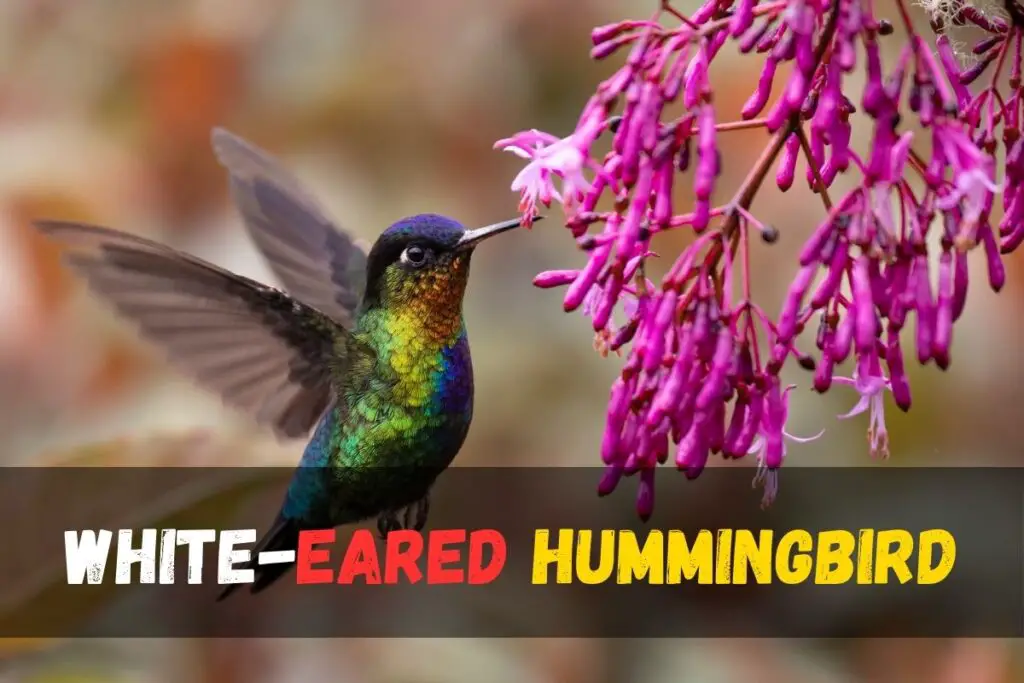
Where to Look for Them:
If you’re keen on spotting White-eared Hummingbirds in Texas, consider exploring areas near the Davis Mountains. These hummingbirds are particularly attracted to montane forests and wooded regions with dense vegetation. Keep an eye on flowering plants like penstemons, salvias, and agaves, as these serve as magnets for White-eared Hummingbirds.
Appearance:
Males boast a spectrum of green colors on their backs, ranging from apple green to dark emerald. Their distinctive white stripe from the eye to the neck is a key identifier. Females and juveniles, on the other hand, have a slightly duller appearance, with bronzy green topsides and bright white eye accents.
Habitat:
White-eared Hummingbirds prefer habitats with scrubby growth and forests, often nesting in shrubs or low trees. In Texas, conservation efforts are crucial due to habitat loss and degradation. Preserving high-elevation forests, woodlands, and riparian corridors is essential to ensure the survival of this species.
Diet:
Their diet is diverse, primarily consisting of nectar from red tubular flowers like trumpet vines and coral honeysuckle. Additionally, they actively hunt small insects and spiders, displaying remarkable agility in capturing prey mid-air or from foliage.
Population:
White-eared Hummingbirds are considered rare in Texas, with only about 0.03% of hummingbird sightings attributed to them. Conservation initiatives aim to address habitat loss and degradation, emphasizing the importance of high-elevation forests, woodlands, and riparian areas.
Conservation Status and Public Awareness:
Texas has identified the White-eared Hummingbird as a species of concern. Habitat loss and degradation pose significant threats, highlighting the need for conservation efforts. Initiatives include the preservation of native vegetation, habitat connectivity, and collaborations with landowners. Public awareness programs play a crucial role in garnering support for the conservation of this unique species.
Migration Patterns and Unique Behaviors:
White-eared Hummingbirds are neotropical migrants, traveling from breeding grounds in Mexico and Central America to Texas during the summer. They exhibit interesting nesting behavior, selecting secluded locations and building cup-shaped nests with plant fibers, moss, and spider silk. Their territorial nature adds to the fascination, as they fearlessly defend their feeding grounds.
Mexican Violetear
Identification
Hummingbird enthusiasts and birdwatchers in Texas have the unique opportunity to spot the mesmerizing Mexican Violetear hummingbirds. Identified by their scientific name, Colibri thalassinus, these hummingbirds are a captivating sight with their distinctive features.

Appearance:
The male Mexican Violetear is a dazzling spectacle, adorned in iridescent green plumage, complemented by vibrant violet ear patches on each side of its neck. The metallic blue-green tail, featuring bronze central feathers with a black band, adds to its allure. In contrast, females are less colorful, lacking iridescence and distinctive violet ear patches.
Identification Process:
Distinguishing between adult males, females, and juveniles involves observing the development of violet ear patches. Juveniles resemble adult females until the males begin acquiring their characteristic violet ear patches. Baby Violetears are easily recognized by their fluffy white feathers near the bottom.
Where to Look for Them:
Mexican violet bears are considered rare in Texas, especially during their breeding season. Observations suggest that these hummingbirds are more prevalent in Central and Southern Texas, with a sightings map providing insights into their distribution. Typically, areas with dense vegetation, such as forests and shrubs, serve as ideal locations for spotting them.
Habitat:
The Mexican Violetear’s breeding grounds extend from Mexico through Central America to Nicaragua, with occasional sightings as far south as Bolivia and Venezuela. In Texas, these hummingbirds exhibit interesting nesting behavior, constructing nests on low branches or shrubs in dense vegetation for protection.
Diet:
These hummingbirds boast a diverse diet, encompassing nectar from flowering plants like salvias and trumpet vines, along with small insects such as flies and beetles. Their long, slender bills facilitate sipping nectar, while their agile flight allows them to capture insects in mid-air.
Population and Conservation:
While the overall population of Mexican Violetear hummingbirds is considered stable, conservation efforts in Texas focus on preserving suitable habitats. The species faces potential threats due to habitat loss and fragmentation. Conservation initiatives aim to raise awareness about the significance of maintaining healthy ecosystems and protecting natural habitats for the sustained well-being of these enchanting hummingbirds.
Violet-crowned Hummingbird
Identification
The Violet-crowned Hummingbird (scientific name: Amazilia violiceps) is a captivating species found in Texas, with a unique identification marked by its purple head, snow-white chest, chestnut wings, and distinctive long, straight red-orange bill. This medium-sized hummingbird has an elegant appearance, complemented by metallic bluish-green tails and a blue-black band across the tail near the end.

Where to Look for Them
To catch a glimpse of the Violet-crowned Hummingbird in Texas, one should explore hidden corners of lush forests. These hummingbirds prefer tropical deciduous forests and semiarid scrub environments. Look for them in areas with sycamore or oak trees, especially during their nesting period between April and September.
Appearance
These hummingbirds exhibit sexual dimorphism, with males displaying vibrant colors while females are less colorful. The male has a violet cap, dark olive-green back, and white underneath. Females have metallic bluish-green tails and lack the colorful throat patch, characteristic of many hummingbird species. The average length is around 4 inches, and they weigh approximately 4-6 grams.
Habitat
Violet-crowned Hummingbirds thrive in a habitat that includes tropical deciduous forests and semiarid scrub. They are known to nest in sycamore or oak trees, showcasing a preference for specific environments.
Diet
The diet of Violet-crowned Hummingbirds is diverse, consisting of nectar, insects, and small spiders. They visit various flowering plants such as trumpet vines and salvias to extract nectar using their slender bills. Their ability to hover and maneuver with agility allows them to capture tiny insects with precision, showcasing remarkable feeding adaptations.
Population
The Violet-crowned Hummingbird is considered a rare and localized species in Texas, facing potential threats from habitat loss, degradation, and climate change. Conservation efforts are crucial to protect and restore suitable habitats, emphasizing native plant communities and riparian corridors. Public awareness programs play a vital role in promoting responsible land management practices to ensure the well-being of this species and other wildlife in Texas.
Green-breasted Mango
Identification
Green-breasted Mango hummingbirds, native to Central America, are a rare but captivating sight in Texas. Their identification involves a combination of distinct physical characteristics and behavioral traits.

Physical Characteristics:
The male Green-breasted Mango is notable for its large size, featuring a long sapphire gorget extending below the chest, a turquoise crown, and dark olive green shoulders and flanks. Wings and tail exhibit dark purple hues, appearing almost black in certain lighting. The tail, when fanned out, displays a range of colors from royal purple mixed with red-orange to magenta. Females, on the other hand, share similar markings with a white chest. Both genders have black, slightly arched beaks.
Behavioral Traits:
These hummingbirds are known for their exceptional flying skills, displaying swift and agile movements as they navigate through the forest with the grace of a darting emerald. While the male actively defends nesting territory with acrobatic displays and vocalizations, the female takes the lead in nest building.
Where to Look for Them:
Green-breasted Mango sightings in Texas are rare, primarily concentrated in the southernmost parts of the state, including Corpus Christi and the lower Rio Grande Valley. Observing these hummingbirds requires patience and a keen eye, particularly in tropical and subtropical environments where they are more likely to be found.
Appearance:
Identifying features include the male’s long sapphire gorget, turquoise crown, and dark olive green plumage. Females have similar markings with a white chest. The distinctive colors, especially the royal purple and magenta hues in the tail, set them apart from other hummingbird species in Texas.
Habitat:
The Green-breasted Mango prefers tropical and subtropical forests during migratory journeys. In Texas, they are considered vagrants, making their homes in lush, verdant environments. Their nests, constructed with leaves, bark, and moss, are typically positioned high in the tree canopy for protection and concealment.
Diet:
With a diverse diet, these hummingbirds feed on nectar from bright, tubular-shaped blooms. Additionally, they consume small insects and spiders, often caught in mid-air or plucked from vegetation. This feeding behavior contributes to the pollination of various plant species, making them ecologically significant in Texas.
Population:
Out of 10,000 hummingbird sightings in Texas, only a small fraction, approximately 0.05%, will be Green-breasted Mango hummingbirds. Conservation efforts are crucial due to their limited distribution and specific habitat requirements. Protecting tropical and subtropical forests, where they reside during migratory journeys, is essential for their well-being.
Costa’s Hummingbird
Introduction:
Costa’s Hummingbirds (Calypte costae) are captivating avian species found in the sun-kissed landscapes of Central America, and notably, in certain regions of Texas. Known for their remarkable aerial acrobatics and vibrant appearance, these hummingbirds contribute significantly to the ecological balance in their habitat.

Identification:
Identifying the Costa’s Hummingbird in Texas is facilitated by its distinctive features. The male, with its iridescent purple crown and throat, is easily recognizable. During courtship displays, it showcases flashy aerial dives and vocalizations, making the identification process an engaging experience.
Where to Look for Them:
Costa’s Hummingbirds are predominantly found in desert scrub, chaparral, and deciduous forest environments. When searching for them in Texas, focus on these habitats, particularly areas with suitable flowering plants and shrubs where they might construct their intricately camouflaged nests.
Appearance:
The male Costa’s Hummingbird boasts a reddish-purple cap and gorget, with long streaming throat feathers. The females, less vibrant, exhibit a predominantly white belly. Both genders have a size of 3.5-4 inches, weighing 2-4 grams. Their adaptability to the challenging desert environment is evident in their unique physical characteristics.
Habitat:
Costa’s Hummingbirds prefer desert and semi-desert habitats. In Texas, they can be spotted in Baja California, southern California, southwestern Arizona, and during migration along the Pacific Coast. Conservation efforts focus on protecting and restoring these habitats to ensure the species’ survival.
Diet:
The hummingbird’s specialized diet primarily consists of nectar from tubular flowers, such as penstemons and desert honeysuckles. Their long, slender bills allow them to reach deep into flowers for extraction. Small insects, spiders, and occasional tree sap supplement their nutritional needs, showcasing their role as essential pollinators in Texas ecosystems.
Population:
While Costa’s Hummingbirds are predominantly southwestern birds, sightings in Texas are relatively rare. Out of 10,000 hummingbird sightings in Texas, only 4 are expected to be of the Costa’s hummingbird. Conservation challenges, including habitat loss and degradation, emphasize the need for ongoing efforts to protect and create suitable environments for their thriving existence.
30 Types Of Ducks In Texas
FAQ’S
How many varieties of hummingbirds are there in Texas?
9 varieties of hummingbirds are common in Texas, out of the 18 species found regularly in the United States. Additionally, 6 other species have made accidental appearances in the state. Therefore, Texas is home to a total of 15 varieties of hummingbirds
Are there hummingbirds in Texas right now?
Ruby-throated Hummingbirds arrive in Texas between mid-March and mid-May. The breeding season spans from early April to early September, with departures for wintering grounds occurring from late July to mid-November.
Considering the current date is in December, it is highly unlikely that there are hummingbirds in Texas right now. The birds would have likely departed for their wintering grounds by mid-November. Therefore, the answer to the question is most likely no, there are no hummingbirds in Texas at this time.
What is the most common type of hummingbird?
The most common type of hummingbird in the Eastern and Central United States and Canada is the Ruby-Throated hummingbird. In the Gulf region, several species can be found. In the Western United States, one may come across Anna’s, Black-Chinned, Calliope, Broad-Tailed, Allen’s, White-eared, and Rufous hummingbirds. Therefore, the Ruby-Throated hummingbird holds the distinction of being the most common type in the specified regions.
What hummingbirds are in northeast Texas?
In Northeast Texas, the only hummingbird species regularly observed is the Ruby-Throat Hummingbird. This region hosts fewer than two dozen hummingbird species that venture into the U.S. and Canada, with only a few species remaining year-round. Therefore, if you’re specifically looking for hummingbirds in Northeast Texas, the Ruby-Throat Hummingbird is the primary and commonly seen species in this area.

Which US state has the most hummingbirds?
Arizona has the most hummingbird species in the U.S., and this information comes from the expertise of David Pearson, an ornithologist associated with the Arizona State University School of Life Sciences. Specifically, as you travel farther south towards Tucson and beyond, you can encounter up to 14 different hummingbird species in this state.
What attracts hummingbirds in Texas?
Hummingbirds in Texas are particularly attracted to a combination of feeder and native plants in your yard. Specifically, plants like honeysuckle, Texas plume, red sage, and purple horsemint are known to be especially appealing to hummingbirds. To enhance the attraction, consider tying orange or red tape to a fence post near the feeder. This visual element, coupled with the presence of these specific plants, creates an environment that hummingbirds find attractive in Texas.
Do hummingbirds stay in Texas all winter?
During the winter in Texas, hummingbirds, specifically Ruby-throated hummingbirds, are present despite the majority migrating away. Some hummingbirds stay in the Lone Star State, while others can be found wandering along the Gulf Coast throughout the winter. Therefore, it can be said that not all hummingbirds leave Texas in winter; some do stay, especially along the Gulf Coast, making their presence felt during the migration period.
What is the rarest color of hummingbirds?
The rarest color of hummingbirds is white. True albinos among hummingbirds lack pigment, resulting in white feathers, pink legs, beaks, and eyes. In 2019, Randy Fullerton of Sardis had the fortunate opportunity to encounter and photograph one of these rare white hummingbirds.

